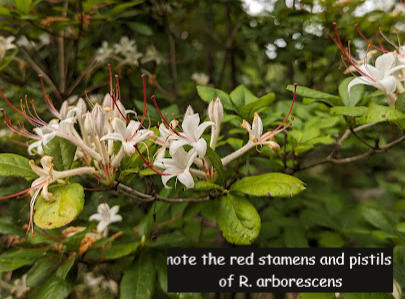Come July most people are justifiably "burned" out from gardening. It's easy to work outside when it's May and 70 degrees, but only the most committed and obsessed gardeners are out there working in sultry mid-July. But there are a wealth of interesting plants that bloom this time of year.
However, most garden centers are biased toward early-season plants like peonies, iris, dianthus, and countless others. We rarely see plants that bloom in July and beyond, things like Crinums, toad lilies, Lycoris, rain lilies... But this is the time of the year when our hummingbirds and butterflies are most active. While I want color in every season, I have a special place in my heart for late summer. This leads me to the subject of late-season native azaleas!

Few people know how many diverse species of native azaleas occur in the southeast. While most of us have seen yellow R. austrinum or pink R. canescens that bloom in early April, only our azalea nerds and native enthusiasts seem to be aware of our later blooming species.
Perhaps my favorite species, if I had to pick just one, is the delightful plumleaf azalea. Rhododendron prunifolium is native to a small area centered around Providence Canyon and along the Chattahoochee River of southwest Georgia. What I find unique about this species is its branching structure and habit. It's been described as tiered or pagoda-like. I also like its intense orange color, although almost every hue between light peach and true red occurs in the wild.

Plumleaf can be distinguished by its glabrous (hairless) leaves and slightly more funnel-shaped, or as I prefer "tubular" flowers. This may be an indication of a possible co-evolution with hummingbirds as this is the only species I've observed being visited by hummingbirds. While each year is slightly different and various specimens can bloom from July till the end of August, I'd aim for around July 20th as peak bloom. If you want to be blown away, I'd suggest visiting Callaway Gardens or Providence Canyon in late July.

While plumleaf is relatively obscure, I do find it more common in gardens than the other two summer-blooming species. Both arborescens and viscosum bloom around this time of year. Rhododendron arborescens (smooth or sweet azalea) is a highly variable species that has both early and late blooming varieties (or species if you are into splitting hairs). It occurs most frequently in the lower Appalachians, but there are also Piedmont forms that exhibit more heat tolerance. While I'm not a botanist or taxonomist, I've seen enough of this to know that the later-blooming variety is distinct and more upright. It does seem to be susceptible to drought as I lost a big specimen last summer. It is usually fragrant, with distinct notes of heliotrope as been described. I get a little bit of the vanilla-like "cupcake" dolls my sister had as a toddler.

Swamp azalea (or Rhododendron viscosum) is also a highly complex assemblage of species. I identify it by its extraordinarily long and narrow blooms with sticky hairs. It is also less glabrous than either arborescens or prunifolium. It has been said that the scent is musky or clove-like, and I do find it distinctive, yet I can't pinpoint the exact aroma. This plant is apparently more tolerant of boggy or water-logged soils, although I've never tested it. At the Davis Arboretum at Auburn, there are some giant swamp azaleas near a stream that seem to confirm this adaptation.
As I mentioned earlier these species are exceptionally rare in cultivation and should be more widely encountered in the landscape. While they do require supplemental moisture in times of drought, they grow rapidly and make great foundation plantings. They do best with morning sun and afternoon shade, but will perform quite well in full sun if well watered. You can find these species at specialty nurseries or at Lazy K in Pine Mountain, Ga.
Comments